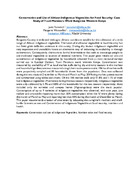| dc.contributor.author | Toroitich, Jane | |
| dc.contributor.author | Wanambisi, Margaret | |
| dc.date.accessioned | 2021-02-15T13:27:03Z | |
| dc.date.available | 2021-02-15T13:27:03Z | |
| dc.date.issued | 2019-06-13 | |
| dc.identifier.uri | http://erepository.kibu.ac.ke/handle/123456789/2309 | |
| dc.description.abstract | Bungoma County is endowed with agro climatic conditions suitable for the cultivation of a wide
range of African indigenous vegetables. The value of traditional vegetables in food security has
not been given sufficient attention in the county. During dry season indigenous vegetables are
very expensive and unavailable hence an alternative way of enhancing its availability is through
conservation. Consequently, there are no formal interventions that seek to encourage people to
use traditional vegetables as sources of essential nutrients. This paper gives results on use and
conservation of indigenous vegetables by households obtained from a cross sectional surveys
carried out in Kanduyi Division, Tuuti Marakaru ward, western Kenya. Conservation was
measured by; availability of IV at local market stalls during dry and rainy seasons in the markets
and household gardens, use was measured using Likert scale questionnaire. 186 local market stalls
were purposively sampled and 80 households drawn from the population. Data was collected
during the two seasons December to March and March to May, 2019using market questionnaires
and summarized using tables and charts. Of the 186 market stalls only 11.8% and 1.1% of them
had indigenous vegetables (9 varieties) during the two seasons respectively. Indigenous vegetables
were only cultivated by 5.9% and 0.8% of the households for the two seasons respectively; these
included only six varieties and cowpea leaves (Vignaunguilata) were the most popular.
Consumption of up to 9 varieties of indigenous vegetables was observed, with cow peas, jute
mallow and amaranths reporting more than 50% consumption when the IV were plenty during
the month of March to May and reporting less than 10% during the month of December to March.
This paper recommends creation of awareness by educating the caregiver’s mothers and smallholder
farmers on use and Conservation of Indigenous Vegetable on food security, nutrition and
health. | en_US |
| dc.language.iso | en | en_US |
| dc.publisher | KIBU | en_US |
| dc.rights | Attribution-NonCommercial-ShareAlike 3.0 United States | * |
| dc.rights.uri | http://creativecommons.org/licenses/by-nc-sa/3.0/us/ | * |
| dc.subject | Conservation and use of indigenous Vegetables | en_US |
| dc.subject | Nutrition value and Food security | en_US |
| dc.title | Conservation and Use of African Indigenous Vegetables for Food Security: Case Study of Tuuti Marakaru Ward Bungoma Western Kenya | en_US |
| dc.type | Other | en_US |

